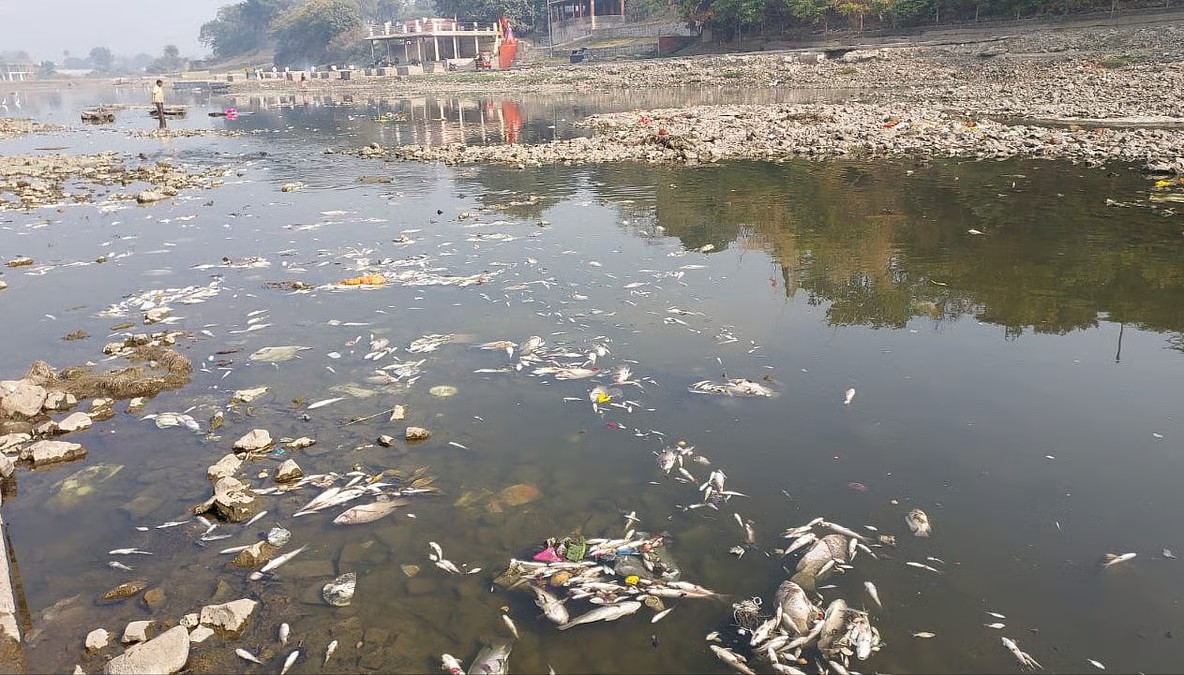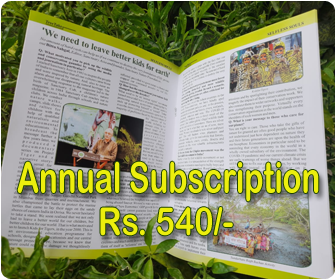Expert Expressions
Dr CP Rajendran is an adjunct professor at the National Institute of Advanced Sciences, Bengaluru, and co-author of the book: The Rumbling Earth – The Story of Indian Earthquakes
The Shipra River, also known as the Kshipra, is a river in Madhya Pradesh. It originates from the Kakri Bardi Hills in the Vindhya Range, north of Dhar district, and flows northward across the Malwa Plateau. The river eventually joins the Chambal River near the Madhya Pradesh-Rajasthan border in Mandsaur district. The Chambal River merges with the Yamuna River near Etawah, Uttar Pradesh.
With a total length of 190 km, the Shipra River drains an area of approximately 5,000 sq km. Its major tributaries include the Khan River near Ujjain and the Gambhir River near Mahidpur. Several important cities and towns—such as Ujjain, Dhar, Dewas, Mahidpur, Barnagar, Alot, Sanwer, Mhow, and Khachrod—rely on the Shipra for their water needs. The holy city of Ujjain, a significant pilgrimage site, lies on the river’s right bank.
The Shipra River (or Kshipra) is considered as sacred as the Ganga by Hindus. It flows through the ancient city of Ujjain, Madhya Pradesh, one of the four sites of the Kumbh Mela. The Simhastha Kumbh (held every 12 years when Jupiter enters Leo) takes place here, attracting millions of pilgrims. The 2016 Ujjain Kumbh Mela saw 75 million visitors over a month, while the 2028 Kumbh is projected to be the largest in history, with 450 million attendees, including 50 million foreign tourists. If accurate, this would surpass previous records set by Prayagraj Kumbh (2019: ~120 million).
Maintaining a continuous flow in the Shipra River during events like the Kumbh Mela and other special occasions poses a significant challenge for water resource managers. Additionally, the river must also meet other competing demands, including irrigation, domestic use, industrial supply, and recreation. Historically, the Shipra River was perennial until the late 1970s. However, over time, it has transitioned into an intermittent flow regime, likely due to the combined effects of climate change and anthropogenic activities.
The Shipra River, a vital water source in the region, is facing significant challenges due to over-extraction and changing environmental conditions. Here’s a breakdown of the key issues and potential concerns: The river serves multiple purposes: drinking water, industrial needs, and irrigation, with agriculture being the dominant land use along its banks.
Three small dams (Sahibkhedi, Kazikhedi, and one unnamed) support an irrigated area of 3,703 km², indicating heavy agricultural dependence. Declining Perennial Nature poses another challenge. The Shipra River now runs dry for 5–6 months a year, suggesting severe water stress. This could be due to: Over-extraction for irrigation and other uses, reduced rainfall or groundwater recharge, deforestation and land-use changes affecting flow.
The dams (Sahibkhedi – 984 km², Kazikhedi – 1,366 km²) help in irrigation but may also reduce downstream flow, contributing to drying, and dams could cause sediment trapping, affecting river ecology. Potential Consequences are reduced flow affects the drinking water supply, especially in cities like Ujjain, and loss of aquatic life and riverine ecosystems. And, water shortages during dry months result in farmers’ over-reliance on groundwater when the river dries up.
The Narmada link is not sustainable in the long run
India’s first high-budget, electricity-driven river linking project, which pumps water from River Narmada into the Kshipra River, facilitated the Mahakumbh dip in 2016. The Rs 432 crore project revived the nearly dry Shipra River in Ujjain.
Under this initiative, the Narmada river was lifted to a height of 350 metres using electric pumps and then diverted 50 km to the Kshipra’s origin. The project involved setting up two pumping stations with capacities of 1,000 kilowatts and 9,000 kilowatts.
The next Kumbh Mela in Ujjain is anticipated to take place between April and May 2028 on the banks of the Shipra River. The excitement surrounding the recently concluded Maha Kumbh (February 2025) has already heightened expectations for the upcoming event, offering pilgrims another opportunity to participate in sacred ritual bathing.
However, beneath the festivities and anticipation, there are undercurrents of concern stemming from the 2016 Kumbh Mela in Ujjain, when water from the Narmada River had to be diverted into the Shipra to maintain its flow, ensuring that devotees were not disappointed by a depleted river. The Narmada-Shipra linking project reflects a misguided priority, promoting artificial solutions rather than genuine efforts to purify and rejuvenate the dying Shipra.
The report on the degradation of the Shipra River submitted by the Comptroller and Auditor General of India is vocal on the environmental concerns and about the administrative oversight and the urgency of rejuvenating the river ecosystem by natural means. The report highlights the pollution and deteriorated groundwater flow within the river basin.
The pollution is attributed mostly to the deficiencies of the sewerage network of the major urban centres in the vicinity of the river and untreated sewerage being dumped in the river. This situation is exacerbated by the unchecked industrial activity that contributes to water pollution. The report stresses on effective implementation of measures ensuring the long-term sustainability of the river system and the free flow of the river.
The challenges ahead
India is currently facing its worst-ever water crisis, driven by climate change and human activity. Glaciers are receding at an alarming rate, groundwater levels are plummeting, and rivers like the Ganga and Yamuna are deteriorating at an unprecedented pace. While rising temperatures are a key factor, unsustainable human practices have exacerbated the crisis. Unregulated groundwater extraction for irrigation, domestic use, and industry has disrupted natural water cycles, creating imbalances that were never anticipated. These unchecked practices have pushed India's rivers into a dire state, demanding urgent action.
The Shipra River basin experiences drought conditions approximately once every 4 to 5 years, with nearly the entire region classified as drought-prone. In recent years, the river has lost its perennial nature, remaining dry for 5 to 6 months annually. The major aquifers in the area consist primarily of basaltic rock formations, except in southern Dewas, where Vindhyan sandstones and Archean granites are found. Aquifer yields are notably higher in the upper reaches of the basin. However, groundwater over-exploitation has become a critical issue, particularly in Indore and Ujjain districts, where the net groundwater draft exceeds the available supply.
The regions of river origin experience tropical dry and wet climates, while the remaining areas are semi-arid. The basin's average annual rainfall is 931 mm. The upper reaches near Indore show high groundwater potential, but much of the basin is dominated by agriculture with minimal forest cover, indicating significant anthropogenic influence on groundwater use. Analysis of pre- and post-monsoon groundwater levels reveals a declining trend across the entire Shipra basin. Additionally, both average annual rainfall and river runoff have decreased substantially over the past two decades.
For monsoon-fed rivers like the Shipra, maintaining optimal groundwater levels is crucial to sustaining river flow during post-monsoon seasons. During the monsoon, when the river's water level is typically higher than the groundwater table, water from the river channel recharges the groundwater. Conversely, in the post-monsoon season, when the river level drops below the groundwater table, the groundwater replenishes the river, ensuring continuous flow.
In most river basins, groundwater levels usually remain below the riverbed because of overexploitation. To address this, Land Use and Land Cover (LULC) changes should be regulated to enhance natural vegetation and tree cover. Expanding dense plantations in forested areas can help rejuvenate groundwater resources, along with the scientific management of groundwater usage. Additionally, constructing recharge structures can directly offset groundwater over-exploitation.
To ensure sustainable management, it is essential to establish a river conservation fund and implement community-led groundwater recharge initiatives with expert guidance. Local community participation, supported by scientific expertise, will be key to preserving these vital water systems.
















Leave a comment